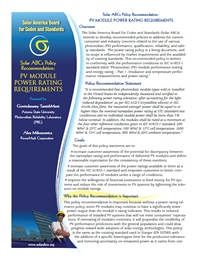
Solar ABCs Policy Recommendation: PV Module Power Rating Requirements
Download the one-page summary (PDF, 1.49MB) or the full report (PDF, 962KB).
Overview

The Solar America Board for Codes and Standards (Solar ABCs) intends to develop recommended policies to address the current consumer and industry concerns related to the use of various photovoltaic (PV) performance, qualification, reliability, and safety standards. The power rating policy is a living document, and its scope is influenced by market requirements and the availability of existing standards. This recommended policy is written in conformity with the performance conditions in IEC 61853-1 standard titled "Photovoltaic (PV) module performance testing and energy rating – Part 1: Irradiance and temperature performance measurements and power rating."
Policy Recommendation Statement
"It is recommended that photovoltaic module types sold or installed in the United States be independently measured and certified to the following power rating tolerance: after accounting for the light induced degradation1 as per IEC 61215 (crystalline silicon) or IEC 61646 (thin film), the measured average2 power shall be equal to or higher than the nominal nameplate power rating at STC (standard test conditions) and no individual module power shall be more than 3% below nominal. In addition, the modules shall be rated at a minimum at the four other reference conditions given in IEC 61853-1 standard: 200 W/m2 & 25°C cell temperature; 500 W/m2 & 15°C cell temperature; 1000 W/m2 & 75°C cell temperature; 800 W/m2 & 20°C ambient temperature."
Why the Report is Important
This policy recommendation is important because without a power rating tolerance policy, some PV modules may continue to have a significantly lower power output than the module's rating indicates. This results in reduced performance of installed PV systems that will not meet consumers' expectations. If overrating of modules continues, it will jeopardize the credibility of PV performance predictions with the general population and could slow progress toward wide adoption of solar energy technologies. This policy is the same as the existing standard used in Europe (EN 50380) with the addition of a specific lower/upper limit for the production tolerance and removing uncertainty on measured power as it varies from one lab to the other and from one test/reference technology to the other. In addition, without power rating data at various low/high irradiance and temperature conditions, the energy collection predictions for installed PV modules and systems will not be accurate.